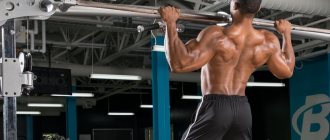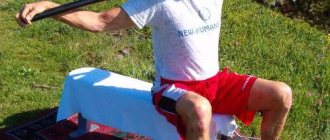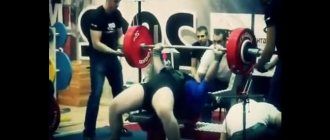The natural processes of aging cause back problems, even if there are no chronic diseases. Osteochondrosis and osteoporosis can be considered diseases of senility. To prevent them, you need to regularly do exercises to strengthen the back muscles for older people, but they are effective only in the first stage of development of the pathology, although they are more often recommended as a preventive measure.
The benefits of physical therapy for strengthening your back
With the help of special gymnastics to strengthen the back muscles, you can achieve the following results:
- strengthen the muscles and ligaments near the spine;
- normalize blood circulation in this area;
- improve overall health with a sedentary lifestyle;
- correct posture problems;
- reduce the risk of developing cardiovascular diseases;
- make the spine more flexible and resistant to stress;
- improve your mood.
They are indicated for all people with back pain.
May be interesting: 8 basic exercises with a stick for cervical osteochondrosis
Benefits of correct posture[edit | edit code]
Read more articles:
- Posture correction
– biomechanical basis of postural disorders - Stage 1
– general recommendations for changing lifestyle and movement patterns - Stage 2
– gymnastic exercises and stretching, necessary to eliminate muscle hypertonicity and mobilize the musculoskeletal system. - Stage 3
– building strength training aimed at strengthening target muscles.
Improving your posture can change your entire life. You will not only appear taller and slimmer, but you will also feel much better, almost forgetting about back pain. Regardless of your age or fitness level, you will benefit greatly from developing good posture using the exercises in this article. Everyone needs good posture as it is important for healthy muscles, bones and injury prevention. Older adults can significantly reduce their risk of falls while enjoying a healthy, active life. Athletes will be able to improve their personal performance in sports arenas.
By training your posture, you will gain the following benefits:
- prevent or reduce the likelihood of lower back pain;
- reduce the number of injuries;
- increase the performance of joints;
- increase your range of motion;
- improve flexibility;
- get more energy.
Rules for exercising in old age
In old age, it is necessary to follow the rules of physical activity, regardless of what type of physical education a person does. The main ones are the following:
- Perform the treatment complex every day. The therapeutic and health-improving effect depends on this.
- In addition to the main set of workouts, it is recommended to do short exercises and cool-downs in the morning and evening.
- The instructions for classes often indicate an average load, so when performing the entire complex it is necessary to modify it, taking into account the patient’s age, his physical fitness, the presence, type and severity of the disease. Therefore, to draw up a training program, it is recommended to consult a specialist.
- While performing the exercises, you need to focus on your own sensations and feelings. If discomfort occurs, physical activity should be reduced.
- Strengthening exercises should be performed at a slow to medium pace. There should be no sudden movements, jerking or jerking. In addition, the pace of the exercise can change during execution, i.e. You can do it slowly at first, then a little faster, then reduce the intensity again. This also applies to the amplitude of exercises. In this case, there should be no discomfort or poor health.
- The feeling of thirst cannot be ignored. It is recommended to drink water or fortified drinks between approaches to a physical therapy complex or movements during measured walking. You can and should drink, but you cannot drink a lot of water at one time, and it is better to do it in small sips. The temperature of the water is also important; cold water should not be consumed.
What is exercise therapy
Therapeutic physical culture is a large group of special physical exercises, the purpose of which is to help restore the tone of any muscle groups. From the point of view of anatomy and physics, the most vulnerable place in the human body is the back and spinal column: from the sacrum to the neck. Therefore, the most relevant today is therapeutic exercises for the back.
There are a lot of exercises in physical therapy. You already know some of them, since you have probably done exercises at least once in your life.
Neurological departments often admit people who cannot straighten up. One day their back was pinched and they couldn’t straighten up on their own. This is due to the pinching of a certain nerve due to the fact that the muscular corset of the lower back cannot provide adequate protection to the spine.
Why are back exercises so necessary? See for yourself:
- Hands - they are always doing something, moving. Even when eating, you hold a spoon in your hands. In general, the arm moves too much for the muscles to atrophy that much.
- Legs - since a person walks, their muscles are also constantly trained.
- What remains is the body. To maintain a straight body position, the back and abdominal muscles must be evenly developed, toned and receive good blood supply. If these conditions are violated (say, with a sedentary lifestyle), the muscles weaken and can no longer perform their functions.
For example, the longissimus dorsi muscle, which runs along the spine, is constantly under stress. During long and motionless sitting, blood flow to it becomes difficult, which reduces its capabilities.
So gradually, depending on our bad habits, the core muscles lose the ability to reduce compression of the spine, the intervertebral cartilage is worn out, and the spinal nerves are pinched. This causes pain and limited mobility.
Thus, the back requires training. If you don’t go to the gym, don’t do exercises in the morning, or are overweight (even if you just have a belly), one day you will have to perform therapeutic exercises to save your back from the progression of diseases.
Contraindications
Gymnastics for the elderly has its contraindications. These include the following:
- the presence of problems with the circulatory system and respiratory organs;
- fractures of limbs and other bones;
- oncological diseases.
Physical activity is not recommended at the last stage of diseases of any nature. This can cause complicated fractures and soft tissue damage.
Physical activity may be limited in old age, in which every bodily movement requires effort.
This set of exercises is not recommended for people with unstable psyches and increased excitability, as this can lead to negative consequences for the entire body.
Basic rules for improving back health and balance[edit | edit code]
Support muscle training is different from strength training. The following tips will help you make your classes as effective as possible.
- Always allow time for warming up.
Since support and balance training is not very long, warming up can be part of it. Active exercises that warm up the muscles well include lunges and squats (one-leg squats are especially useful). Push-ups are also effective. The main thing is not to do the exercises as hard as you can, but work at a calm pace suitable for warming up.
- Focus on muscle endurance.
To strengthen the supporting muscles, it is very important to increase muscular endurance. Depending on the complexity of the exercise, perform it 12-20 times. If time permits, do 2-3 approaches.
- Take 30 second breaks.
The rest period should be short, since the main thing here is to develop muscle endurance.
- Keep an eye on your technique.
Do not continue working if you are tired and can no longer perform the exercise correctly. Since these exercises are designed to improve the efficiency of movements, their correctness is very important with each repetition.
- Listen to your body.
You must be very careful to avoid any strain on the muscles in your lower back or neck. Listen to the signals your body is giving you. If certain exercises cause you pain, just don't do them. If you have any back problems, follow the recommendations of your doctor or personal trainer.
- Always stretch.
You can stretch both after specific exercises during rest, and at the very end of the workout. Meanwhile, in any case, do not forget about stretching to develop muscle balance, increase your flexibility and ease of movement.
A set of exercises for the back
The exercises are performed in 3 stages:
- Warm up. The purpose of this stage is to warm up the muscles, making them more elastic.
- Main load. At this stage, a set of basic exercises is performed, which is the most difficult to perform.
- Hitch. At this stage, the spine is relaxed and prepared to return to its natural position.
At each stage, a different number of exercises can be performed. Below is a set of 5 exercises for each group.

Warm-up:
- You need to straighten your spine, raise your arms and try to reach for the ceiling, while rolling onto your toes. Number of exercises: 5–10.
- Marching step for 2 minutes. When performing this exercise, you need to raise your knees as high as possible. Your hands should also work.
- Bend the torso to the side. In this case, the legs should be closed and the arms should be lowered along the body. The slopes should be shallow.
- Bend forward, with your hands clasped together.
- Raising your arms above your head. During exercises, your feet should be shoulder-width apart.
Main complex:
- You need to lie on your back on a special mat, stretch your arms along your body. After this, you need to simultaneously raise your parallel arms and pull your toes towards you.
- Side crunches. To do this, you need to stand with your legs apart. Alternately turn your torso in each direction, returning each time to the starting position. Repeat the exercise 10 times for the left and right sides.
- Rotations while sitting. The principle of performing the exercise is the same as in the previous case, but it must be performed while sitting on a chair. Additionally, you can hold light dumbbells at chest level so that your shoulders are relaxed.
- Squats with a chair. You need to stand in front of a chair, legs apart. Now you need to sit down until you touch the chair. You need to make sure your back is straight. Additionally, you can hold the ball. Repeat squats 10 times.
- Wall push-ups. You need to stand a short distance from the wall and place your palms on it at shoulder level. Now alternately bend your elbows and straighten them. In this case, the back should be straight, only the abdominal muscles should tense.
Hitch:
- Slow inhalation and exhalation using the abdominal muscles.
- Voluntary breathing, accompanied by 10 sharp contractions of the pelvic muscles. Each time they need to be held in tension for 3 seconds.
- Balance training. You need to stand on one leg, bend the other at the knee and lift it. Hands are spread out to the sides. You need to stand in this position for as long as possible. Repeat for the other leg
The benefits of a straight back

The ideal surface of the back is not only for appearance, it gives vigor and self-confidence. It promotes the proper functioning of internal organs.
Strengthening the muscular corset of the back allows you to avoid straining your muscles. An ideal back prevents the occurrence of kyphosis and scoliosis.
Benefits of good posture:
- Light load on the spine.
- Normal functioning of internal organs.
- Protection from many diseases.
- Presentable appearance.
Over the years, the muscle corset becomes weaker and less flexible. A large curvature appears, the legs are bent at the knees and the chin moves forward.
During the aging process, the elasticity of the tendons decreases, the structure of the bone tissue changes, and the intervertebral discs are destroyed.
A stooped back characterizes a person who is insecure. The processes can be suspended if you monitor the position of your back and regularly perform gymnastics.
Suitable exercises stimulate blood flow, protect against pain symptoms and strengthen the muscle corset.
Exercises for older people from Dr. Bubnovsky
The basis of back treatment from Dr. Bubnovsky is the principle of kinesitherapy. Most exercises are performed on a specially designed MTB machine. Such gymnastics helps eliminate pain, normalize the tone of the deep back muscles, and increase joint mobility.
As an alternative to perform at home, you can use an expander.
The classic complex from Bubnovsky for the spine includes the following exercises:
- Walking on your buttocks. When performing the exercise, you do not need to rest your hands on the floor. You can make the task more difficult by raising your legs.
- Raising bent legs in a sitting position. This should be done alternately for each leg. Place your hands on the floor.
- You need to sit on the floor and lean your hands on it. Bend your legs, then alternately straighten and turn your toes to the side.
- Extending the bent leg to the side from a sitting position.
- Exercise “Bicycle”.
Rules for performing gymnastics
Therapeutic exercise is good for health, but you need to follow the rules and perform the exercises correctly. To avoid harming yourself, you should consult a specialist and follow his instructions . The rules are presented with simple requirements that are not difficult to comply with. If the goal of physical exercises for the back is not only to strengthen muscles, but also to eliminate pain and pathologies, then the complex is prescribed only by a doctor after an appropriate examination.
Before performing gymnastics, you must warm up your muscles. The back must be prepared for stress, since an abrupt start to exercise is stressful for any part of the body and organism. In this case, there is a high risk of injury.
A common mistake newbies make is overloading. In one session it will not be possible to correct all existing deficiencies and develop the back muscles; this requires a long period of physical therapy. A competent increase in load is the right decision.
If during the training you experience any discomfort, discomfort or pain, then the training should be stopped immediately. In some cases, changing the exercise helps, but this seems possible when performing the exercises under the supervision of a specialist who has the necessary knowledge and is in complete control of the situation.
It should be understood that when strengthening your back, it is difficult to achieve good results if the load is not applied to other muscle groups in the body. The overall load is more beneficial than impacting one category of muscle corset. You can conduct classes both in the gym and at home, using improvised means.











